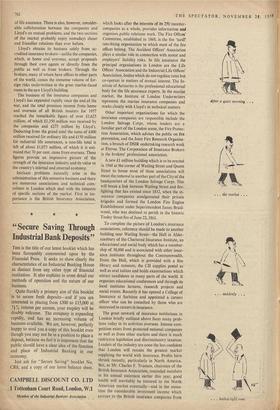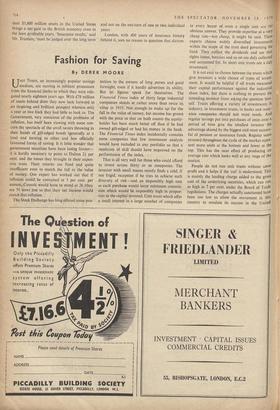That is all very well for those who could afford
to invest across thirty or so dompanies. The investor with small means mostly finds a cold, if not frigid, reception if he tries to achieve such diversity of risk—and an impossibly high cost as each purchase would incur minimum commis- sion which would be impossibly high in propor- tion to the capital invested. Unit trusts which offer a small interest in a large number of companies
S.2
People do not run unit trusts without some profit and it helps if the 'cut' is understood. This is mainly the loading charge added to the gross cost of the underlying securities, which can run as high as 7 per cent. under the Board of Trade regulations. The charges actually sanctioned have been too low to allow the movement in this country to emulate its success in the United
SINGER & FRIEDLANDER
LIMITED
MERCHANT BANKERS
INVESTMENT CAPITAL ISSUES COMMERCIAL CREDITS
55, BISHOPSGATE, LONDON, E.C.2
States, where the total invested in this way is £3,600 million. The only way to prosper is to have a large family of trusts in the group—it is literally cheaper by the dozen. New trusts are always expected to run at a loss for a time—despite the loading charge. The type of salesmanship which modern times require is expensive. Probably £25,000 might not cover the costs of a new trust in the first year, taking into account advertising, setting up new offices, staff, ,rents, and, not least, management (always surprisingly low for the responsibilities they shoulder). A charge of 2 per cent. net means that £1,250,000 worth of stock has to be sold to get the trust's management accounts out of the red.
There is the minor advantage in the way the prices are fixed under Board of Trade regulations. These are based on the market quotations, but actual deals are made under that figure. However, for all practicable purposes it would not be pos- sible to improve on the present system. This mini- mal benefit is also supported by an annual charge —deducted painlessly from the half-yearly pay- ments of income—which works out usually at about 10s. per cent., or about one-ninth of the year's gross income at present for most trusts. There is sometimes a final benefit for some trusts on the sale of the units but this largely depends on whether unit-holders specify—as they should —that the selling price should be calculated on the Board ot Trade formula.
Here is a selection of Unit Trusts to suit most tastes. It is not exhaustive but merely a guide t9 what is available. in the past year. Its trusts include British Indus- tries Flexible Trusts which have up to 125 hold- ings and pay out the income every six weeks. There is Metals & Minerals Trust which invests in up to 100 companies with 35 per cent. in oils, gold and diamonds and 13 per cent. in mining finance. Then there is Electrical & Industrial Development Trust with 124 securities of which 17 per cent, are in atomic power.
Bank Insurance Group : 2-tm. Scotbits, the only Scottish Unit Trust, have been sold in a year, many of them over the counters of the Scottish joint stock banks. £100 invested in Scotbits ten years ago is worth £270 today.
Orthodox : Plays for safety with 45 per cent. of the money in gilts, fixed interest or bank or insurance shares. Another 45 per cent. is in industrial equities and the remaining 10 per cent. in gold shares.
The 'M & G' General Trust Fund : The price of the units has risen by 53 per cent. between 1951 and 1958 during which time the Financial Times index has risen by 43 per cent. About 10 per cent. of the portfolio is in oil shares, 13 per cent. in US utilities and the rest in widely diverse industries. The group operates a thrift scheme
NEW UNIT TRUSTS
No fewer than three important new Unit Trusts are likely to be announced shortly. Well-known City merchant banks are sponsoring the issues. among them Rothschild, Philip Hill and, it is believed. Robert Fleming. The Philip Hill offer may be the largest of its kind in this country. exceeding £2.000,000.
































































 Previous page
Previous page